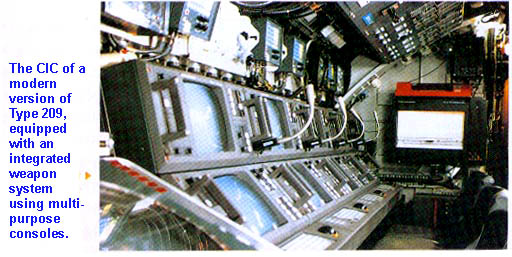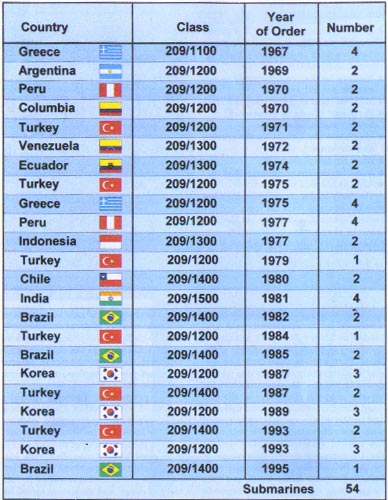The World of Type 209 Submarines :
A Success On The Export Market
The Birth of Type 209 Sub
30 years ago, in 1967, the shipyard known as Kieler Howaldtswerke signeda contract in Athens for the delivery of four submarines of approximately
1000t displacemnet to the Royal Hellenic Navy.
Meanwhile, Kieler Howaldtswerke has become Howaldtswerke-Deutsche Werft
AG(HDW), the Greek naval forces call themselves simply the Hellenic Navy,
and the 1000t submarine has officially been designated Type 209 by the
German Ministry of Defence. This contract was the first of many for these
submarines, which have become the most frequently constructed conventional
submarine class of the West.
By the early 1970s, many navies found themselves in a position where they
had to replace their old pre-war submarines and those handed over by the
Allied forces after WWII which were becoming outdated. At that time the
French Daphne Class and the British Oberon Class submarines, built for the
respective home navies, were also successfully marketed to foreign navies.
It is remarkable that the Type 209 was a success without the submarines
being used by the German Navy as a point of reference. Subsequent orders
were received. in 1969 for Argentina, 1970 for Peru and Columbia, 1971 for
Turkey and 1972 for Venezuela.
The Superior Features
The design of this submarine was initially based on those built for the Ger-man Navy, though these were small boats of the same components could be used
to equip the larger submarine, partly by doubling the equipment,e.g. installing
four diesel generators instead of two. The single hull construction for Type
209 was relatively simple and clearly laid out-it was the idea of Professor
Gabler,owner of the engineering and design office Ingenieurkontor Luebeck that
was largely responsible for the design, to enable the Commanding Officer to see
along the entire submarine from the torpedo tubes in the bow to the end of the
Engine Room in the stern from a position standing at the periscope. For this
reason, the CIC was situated about halfway along the hull.

Principal arrangement of the first Type 209 submarines in 1967
Forward and aft of this area, the lower deck consisted of large battery rooms
altogether amounting to about 25% of the total displacement. This gave the
submarines good submerged endurance. The low-revolution 5000HP electric motor
that acted directly on the propeller shaft enabled high speeds of more than 20
knots to be achieved.

The fuel cell: handled like a normal battery cell but with very special demands for its
operation on board
These characteristics-good submerged range, high submerged speed and good
handling aspects of the submarine as a whole-are still today the decisive features
of the Type 209 submarines. Export success was largely due to the contract in 1969
to build Type 206 submarines for the German Navy awarded on the General Contractor
Principle which meant that the construction shipyard as General Contractor was
responsible for the correct functioning of the submarine as a whole, including tests
and trials and successful firing of exercise Torpedoes. This equipped the shipyard
with the necessary personnel, material resources and experience to assume the role
and the responsibility required of the General Contractor for export orders.
Another reason for the success of the Type 209 was that the following major subcontr-
actors in Germany were renowned and had the capacity:
 Siemens for the propulsion motors and electric control systems
Siemens for the propulsion motors and electric control systems
 MTU for the diesel engines/generators
MTU for the diesel engines/generators
 Varta and Hagen as experienced battery manufacturers
Varta and Hagen as experienced battery manufacturers
 Maschinenbau Gabler for the snorkel and antennae
Maschinenbau Gabler for the snorkel and antennae
 Zeiss for the periscopes
Zeiss for the periscopes
 Atlas for the sonar systems, and
Atlas for the sonar systems, and
 AEG as torpedo manufacturer.
AEG as torpedo manufacturer.
The only major items subcontracted outside Germany were the radar and fire control
systems, and following the line taken by the German governmental procurement authorities,
orders were placed with the Dutch company HSA and the French manufacturers Thomson.
With the continued interest of foreign navies in the basic design of the Type 209
submarines leading to more orders, advances in the electronic field proceeded at a
very fast pace, making it necessary to adapt the eqiupment of the bats, Furthermore,
customers had special requirements, largely due to the desire to use specific sub-
contractors for logistic reasons. Thereby, on the one hand familiar equipment was
updated, and on the other experience was gained with new subcontractors, For example,
fire control systems manufactured by the US company Singer Librascope or by the British
company Ferranti were intalled, whilst Atlas which not only makes sonar systems but also
began to specialise in the delivery of complete integrated weapon systems, its "IUS"
system were fitted to some of the newest submarines.
The incorporation of new equipment of different weapon systems automatically leads to
configuration changes elsewhere in the submarine, as the changes imply different space
requirements, altered electrical power supplies, other cooling facilities, etc.

The propulsion system initially equipped with suction diesel engines and later with
supercharged engines, notably increased performance values. With the assistance of the
two earlier mentioned battery manufacturers, battery quality was improved in both low
and high power areas, resulting in submerged range and maximum speed being retained in
spite of the increase in size of the submarines.
Orders for submarines with mission profiles including operations in the Caribbean or
Southeast Asian waters made it necessary to develop and install adequate air-conditioning
facilities for crew and electronics, with the appropriate degree of redundancy.
Depending on the specific requirements ordered by different customers, the size of the
submarines increased from the original 1000t displacement and in some cases by as much
as 50%. The additional size and space were needed to accommodate increases in range,
crew living quarters, more electronic equipment and in some instances increased diving depth.
The net result has been the emergence of the "Type 209 family" comprising very varied
submarines as family members.
One of the constant aims in the continued development of the submarine was the reduction
of self-noise. Thanks to the large number of orders that followed each other in an almost
annual sequence, every contract profited from the most recent results of research and
technology, improvements tested during sea trials which could then be incorporated into the
next project. This achieved surprisingly low radiated noise levels to be achieved both
during snorkelling and in submerged cruising.

List of contracts for Type 209 submarines
Many of the tests were possible due to the close and helpful cooperation of the German
Ministry of Defence test sites and the use of their special measuring equipment. Although
the Type 209 submarines have never been commissioned under the German flag, the German
authorities and the Navy have made a great contribution to their success in export orders.
The armaments division of the German Ministry of Defence in Bonn and the Federal Office of
Military Technology and Procurement in Koblenz provided inspectors and facilities to monitor
the technical concepts and design, and also participated in inspection duties during
production on behalf of customers. This is why the submarine was given the official German
fleet name Type 209. On request of customers, the German Navy Submarine Flotilla is willing
to conduct basic personnel training and has frequently given further assistance after
commissioning to ensure that the crew is fully operational.
Next Generation, Type 212 Technologies for Type 209
Now that the new Type 212 submarine has been developed for the German Navy, naturally theType 209 submarines would also benefit from new technologies that have been implemented for
the first time. One of the main items of interest for other navies will be the airindependent
propulsion system using fuel cells. Existing submarines can be modified by the addition of a
specially designed section and the design for new constructions can be updated with an
integrated solution. The addition of fuel cell with its fuels H2 and O2 carried on board enables
the already good submerged range with strong conventional batteries to be increased 4-fold,
while retaining this battery at full strength permits an hour submerged at high speed.
Among the modern technologies that can be adopted from the Type 212 design are the permanent
magnet(PM) propulsion motor, whichrequires considerably less revolutions at a given speed due
to its increased efficiency. Together with the specially designed propeller, this leads to a
further reduction in hydredynamic noise.
Since the first Type 209 submarines were ordered, rapid developments especially in the
electronics field have resulted in a marked change in performance characteristics in comparison
with the boats built today. This can be remedied by modernisation of the older submarines. The
first four submarines of this class, ordered 30 years ago for the Hellenic Navy, are being
subjected to thorough modernisation, in particular the entire weapon system. Similar measures
were taken in the early 90s for the two Venezuelan submarines. Together with the possibility of
adding a whole section to accommodate an air-independent propulsion system, there is a wide
range of possibilities of adapting existing boats to future requirements.
Both by modernising existing submarines and due to the many possibilities of introducing new
technologies into new constructions, Type 209 promises to remain an interesting competitor on the
international market in coming years.
sourece : ASIAN DEFENCE JOURNAL 12/97 p53~54